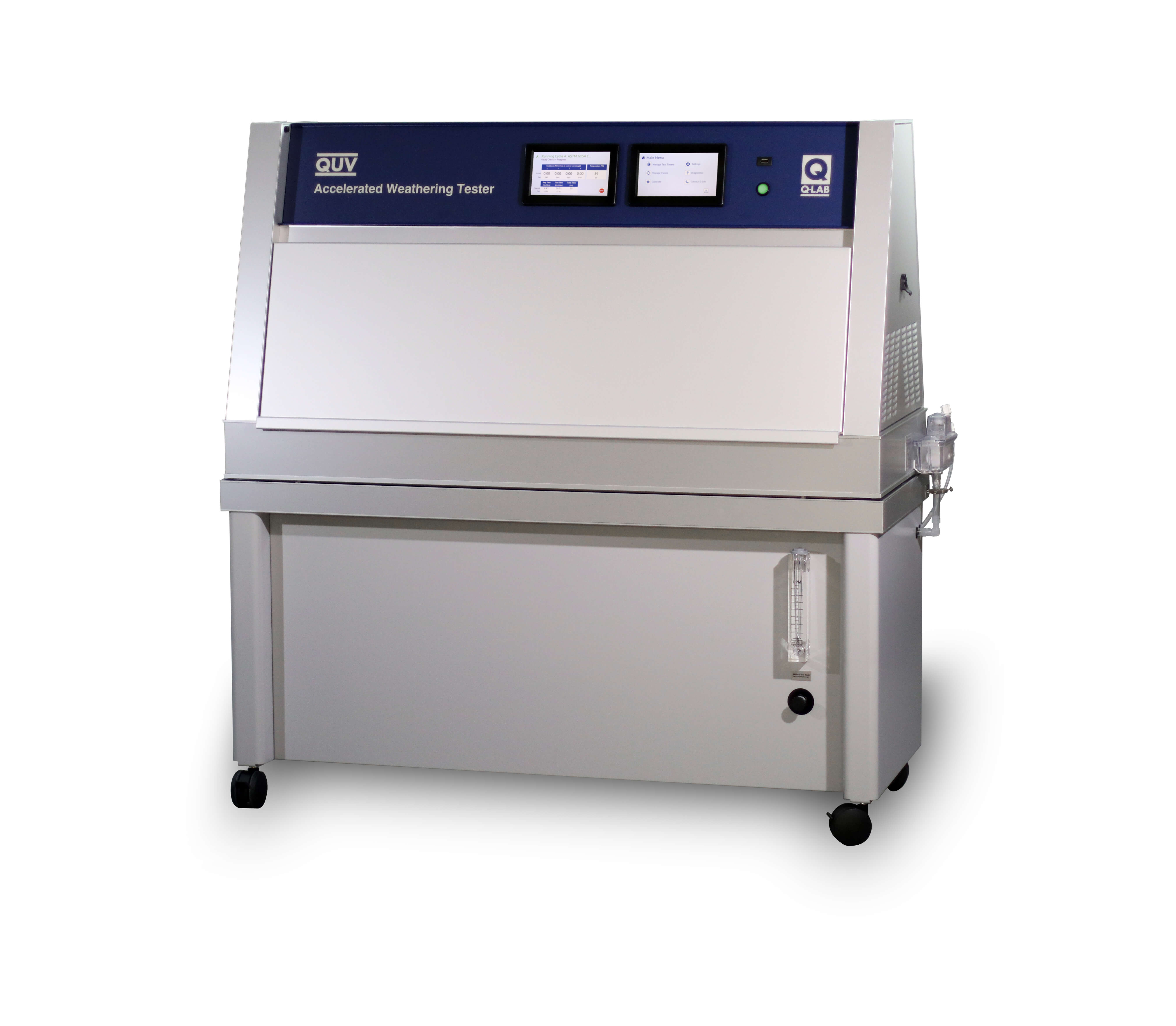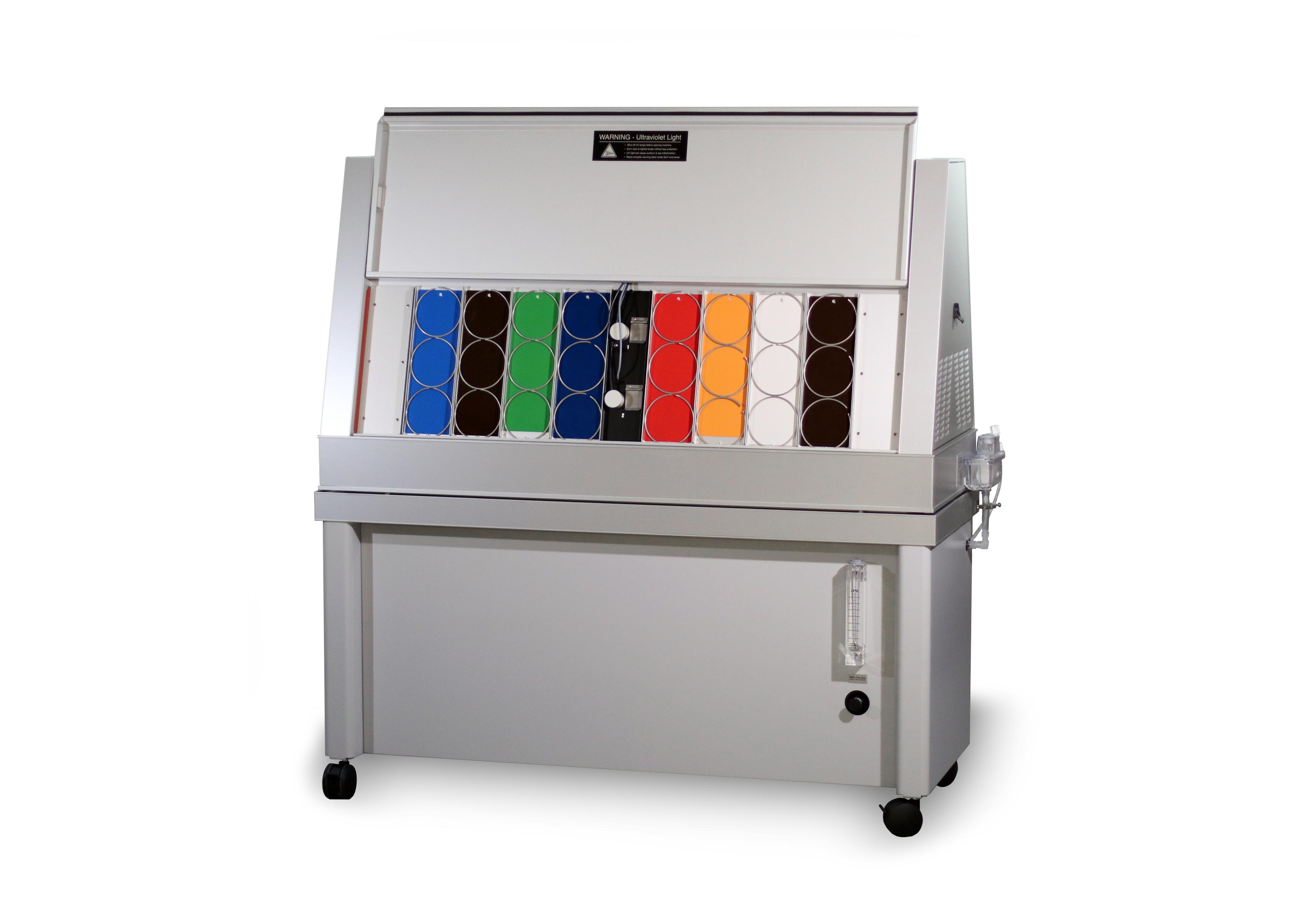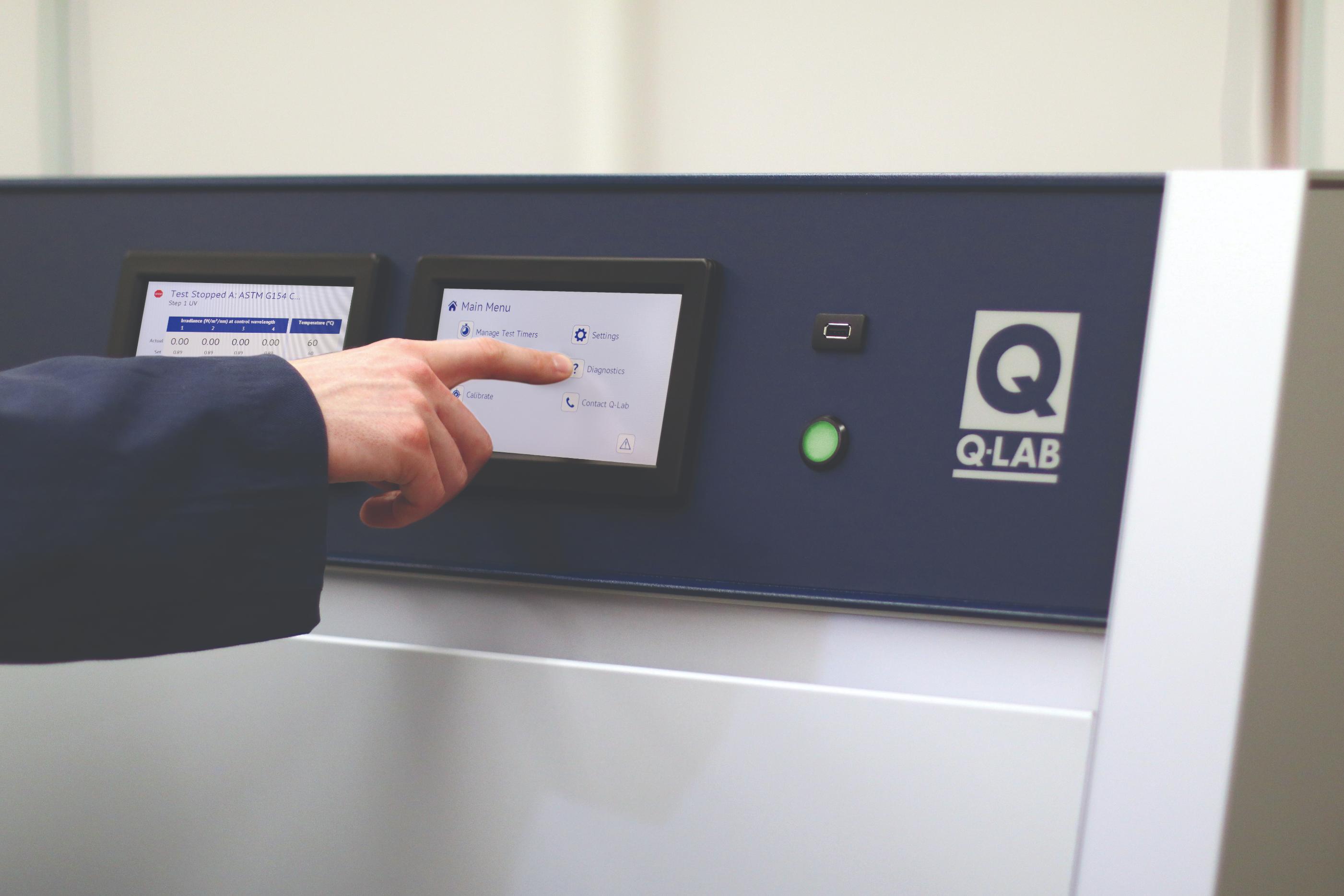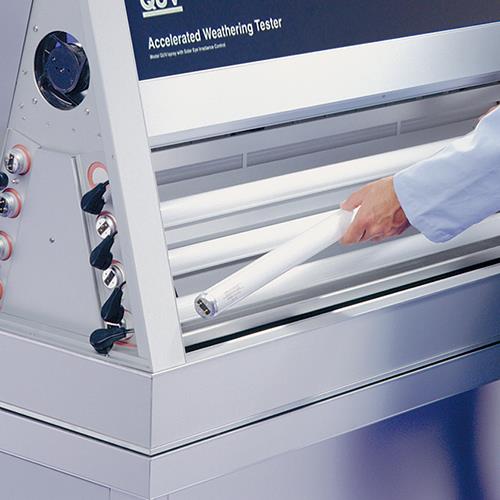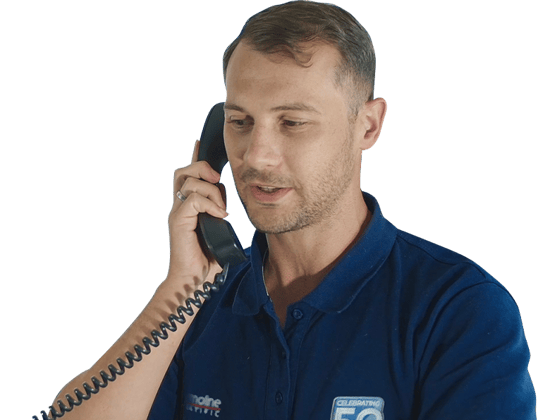QUV Accelerated Weathering Tester QUV
The QUV tester's design is uncomplicated and refined, making installing, operating, and maintaining effortless. Its simple user interface allows for easy programming, continuously displaying exposure conditions. The tester also features self-diagnostic warnings and service reminders to ensure optimal performance.
The patented AUTOCAL system makes quick calibration possible, further streamlining the testing process, while the tester's multicoloured LED provides users a clear view of its status from a distance, adding to its user-friendly design.
Overview
Sunlight, heat, and moisture cause millions of dollars of material damage every year. The QUV accelerated weathering tester reproduces the damage caused by sunlight, rain, and dew. In a few days or weeks, the QUV can generate the same degradation that occurs over months or years outdoors. The QUV tests materials by exposing them to alternating cycles of ultraviolet (UV) light and moisture at controlled, elevated temperatures. The QUV simulates the effects of sunlight with fluorescent UV lamps, and it simulates dew and rain using condensing humidity and/or water spray.
Will your product last outdoors? Don't guess when you can test!
UV light is responsible for almost all photodegradation of durable materials exposed outdoors. The QUV tester's fluorescent lamps simulate the critical short-wave UV and realistically reproduce the physical property damage caused by sunlight. Types of damage include colour change, gloss loss, chalking, cracking, crazing, hazing, blistering, embrittlement, strength loss, and oxidation. Dew, not rain, is responsible for most of the wetness that occurs in outdoor exposure. The QUV UV test chamber's condensation system realistically simulates dew and accelerates its effect using elevated temperatures. The condensation process automatically purifies the ordinary tap water used in the system. This is because the process of evaporating and condensing the water onto the specimens is actually a distillation process, which removes all impurities.
The QUV tester conveniently accommodates up to 48 specimens (75mm x 150mm) and complies with a wide range of international, national, and industry specifications, ensuring the reliability and reproducibility of your test program.
Benefits
- Accelerated Testing: The QUV tester quickly simulates long-term outdoor conditions in a matter of days or weeks, providing rapid feedback on material durability.
- Energy Efficiency: The QUV is economical to purchase and operate, using low-cost fluorescent UV lamps and ordinary tap water for condensation.
- User-Friendly Operation: The QUV tester's intuitive programming, dual full-colour touchscreen displays, and automated operation make it easy to use and maintain.
The QUV weathering tester is a versatile and essential tool for various industries, providing accelerated testing to simulate long-term exposure to environmental elements. Here are some common uses:
1. Coatings and Paints
- Durability Testing: Assessing the longevity and performance of coatings and paints when exposed to UV light, heat, and moisture.
- Colour Stability: Evaluating colour changes and fading over time due to UV exposure.
- Gloss Retention: Testing the ability of coatings and paints to maintain their gloss and finish under outdoor conditions.
2. Polymers and Plastics
- UV Resistance: Determining the resistance of plastic materials to UV-induced degradation, such as cracking, chalking, and colour changes.
- Mechanical Properties: Testing the impact of prolonged UV exposure on the mechanical strength and flexibility of polymers.
- Product Development: Supporting the development of new plastic formulations with enhanced UV stability.
3. Construction Materials
- Weather Resistance: Evaluating the performance of construction materials such as roofing, siding, and insulation when exposed to UV light, moisture, and temperature fluctuations.
- Durability Assessment: Testing materials for long-term durability and resistance to environmental wear and tear.
- Material Innovation: Assisting in the development of new construction materials that offer superior weather resistance.
4. Automotive Industry
- Exterior Components: Testing the UV and weather resistance of automotive exterior parts, including bumpers, trim, and paint.
- Interior Materials: Evaluating the durability of interior materials like dashboards and upholstery when exposed to UV light.
- Performance Verification: Ensuring that automotive materials maintain their performance and appearance over time.
5. Textiles and Fabrics
- Fade Resistance: Assessing the colourfastness and resistance to fading of textiles and fabrics when exposed to sunlight and moisture.
- Strength Testing: Evaluating the impact of UV exposure on the tensile strength and durability of fabrics.
- Product Improvement: Helping develop fabrics with improved resistance to environmental damage.
6. Adhesives and Sealants
- Bond Strength: Testing the long-term performance and bond strength of adhesives and sealants under UV exposure.
- Durability: Assessing the durability and resistance of sealants to environmental factors like moisture and temperature changes.
- Formulation Development: Aiding in the creation of adhesives and sealants with enhanced weather resistance.
7. Electronics and Solar Panels
- Component Testing: Evaluating the durability of electronic components and housings against UV light and environmental conditions.
- Solar Panel Testing: Assessing the performance and longevity of solar panels and their materials under prolonged UV exposure.
- Innovation Support: Facilitating the development of more robust and weather-resistant electronic and solar technologies.
8. Packaging Materials
- Shelf Life Assessment: Testing the impact of UV light on the shelf life and integrity of packaging materials.
- Material Stability: Ensuring that packaging materials maintain their strength and appearance under exposure to sunlight and moisture.
- Product Safety: Verifying that packaging materials protect their contents effectively over time.
The QUV weathering tester is invaluable for ensuring the quality, durability, and performance of materials and products across these and many other industries, helping manufacturers deliver reliable and long-lasting solutions to their customers.
QUV Models
QUV/se
The most popular QUV model features the SOLAR EYE Irradiance Control for precise maintenance of UV light intensity. The QUV/se uses a proven condensation mechanism to simulate outdoor moisture attack. It allows faster, more reproducible testing, longer lamp life, and calibration according to international standards.
QUV/spray
The QUV/spray is the same as a standard QUV/se, but also includes a water spray system for enhanced water delivery. Short periods of spray can be used to create a thermal shock. Longer periods can be used to achieve mechanical erosion. The QUV/spray can be set to generate UV light, condensation, water spray, and even combinations of light and moisture.
QUV/cw
Some industries have test methods that specify using cool white lamps for indoor photostability testing. To reproduce indoor light conditions, the QUV/cw has a SOLAR EYE Irradiance Control system which has been modified to monitor and control the light output of cool white fluorescent lamps.
QUV/uvc
UV light is used widely in ultraviolet germicidal irradiation (UVGI), a technique used to eliminate harmful viruses and bacteria. This short-wavelength, high-energy UVC light can also degrade the materials and surfaces it disinfects. The QUV/uvc model uses UVC lamps to deliver light concentrated at 254 nm to test for material durability against photodegradation effects from UVC light exposure. The QUV/uvc tester has multiple safety features to prevent stray UVC light from escaping; it is also not equipped with condensation or water spray.
The World Standard in Weathering
With thousands of testers in service worldwide, the QUV is the world's most widely used weathering tester.
Specifications
- Dimensions
-
se spray cw uvc External WxDxH (mm) 1370 × 1350 × 530 - Technical Specifications
-
se spray cw uvc Specimen Orientation 75° from horizontal UV Fluorescent Lamps Quantity: 8 (T12 × 121 cm long) @ 40 W ea Onboard Irradiance Sensor Wideband
(250-400 nm)Wideband
(250-400 nm)Broadband
(300-800 nm)Narrowband
(254 nm)Black Panel Temperature Light 35-80 °C 35-80 °C 35-80 °C 28-73 °C Condensation 40-60 °C 40-60 °C — — Specimen Exposure Area 20 × 50 cm
(2× each side)
20 × 50 cm
(2× each side)
4000 cm² total
Specimen Capacity 48 Specimens
(75 × 150 mm)Inlet Water Pressure 0.2-5.5 bar
(2-80 psi)2.8-5.5 bar
(40-80 psi)0.2-5.5 bar
(2-80 psi)— Inlet Water Purity Tap Water > 200 kΩ∙cm
< 5 μS/cm
< 2.5 ppm TDS
6-8 pHTap Water — Water Consumption Condensation 5 L/day 5 L/day 5 L/day — Spray — — 7 L/minute — Weight 136 kg (300 lbs) Electrical Requirements 120 V ± 10 %, 1-
60 Hz, 16 A
230 V ± 10 %, 1-
50/60 Hz, 8 ALab Recommendations Temperature 23 ± 5 °C Relative Humidity 50 ± 25 % - Features
-
se spray cw uvc SOLAR EYE® Irradiance Control ✔ ✔ ✔ ✔ User Interface Available in 17 Languages ✔ ✔ ✔ ✔ Dual Full-Color Touch-Screen Displays ✔ ✔ ✔ ✔ Multi-color LED Status Indicator ✔ ✔ ✔ ✔ Easy Calibration with Universal Calibrator Smart Sensors ✔ ✔ ✔ ✔ Condensation ✔ ✔ ✔ X Water Spray X ✔ X X USB Port for Software Updates and Data Acquisition ✔ ✔ ✔ ✔ Automatic Fault Recognition and Alarms ✔ ✔ ✔ ✔ Automatic Shut-down Timer ✔ ✔ ✔ ✔ Uninsulated Black Panel (BP) Temperature Control ✔ ✔ ✔ ✔ Insulated Black Panel (IBP) Temperature Control Optional Optional Optional Optional Near-Room-Temperature BP Control X X X ✔ Adjustable 3D Specimen Holder Boxes Optional Optional Optional Optional Space Saver Frame for Stacking Optional Optional Optional Optional Water Repurification System X Optional X X
Downloads
Support & FAQs
At Thermoline, we strive to supply helpful customer support to ensure that you get the most out of our products. We are committed to providing whatever support our customers need, wherever they are in the world. If you can't find your solution in the below FAQs or Knowledge Base, please contact our friendly support team.
- What is the main reason you would need a QUV Spray, when dew is the main driver of wetness on samples?
- The QUV/spray is the same as a standard QUV/se, but also includes a water spray system for enhanced water delivery. Short periods of spray can be used to create a thermal shock. Longer periods can be used to achieve mechanical erosion. The QUV/spray can be set to generate UV light, condensation, water spray, and even combinations of light and moisture.
- Why do you need lab grade pure water for the water spray in a QUV?
Impurities in water can leave deposits on test specimens, thus spoiling the opportunity to evaluate their appearance as degradation occurs. Also, the tester can suffer performance issues or mechanical breakdowns due to the prolonged deposition of impurities from water.
Q-Lab offers a water repurification system to significantly reduce the cost of running the QUV tester’s optional water spray system. The system can save over 1,000 litres of expensive, purified water per day in a test cycle that calls for several hours of water spray and can pay for itself in a matter of months. In standalone QUV testers, the water repurification system is fully integrated into the tester below the test chamber.
- How many hours in QUV equals x-amount of years outdoors?
Weathering experts have tried to find that magic number for decades, but there is no such one. No matter how the question is formulated, the answer is always the same: “It depends!” It depends on one simple reason: Mother Nature is not as reliable as lab equipment!
There is no direct conversion between the hours of exposure in a QUV tester and the amount of time spent outdoors, as the intensity of UV radiation and other environmental factors can vary widely depending on location, season, and weather conditions. So, unfortunately, there is no magic number that we can you that can tell you.
QUV testers are designed to simulate accelerated aging under controlled conditions, and the results are intended to be used as a comparative tool to evaluate the relative performance of different materials or coatings. Outdoor exposure, on the other hand, is subject to a wide range of variables that are difficult to control or predict.
- What is the difference between UV and Xenon testing?
UV and Xenon testing are accelerated weathering tests commonly used to evaluate the durability and performance of materials, coatings, and products under exposure to sunlight and other environmental factors. However, there are some critical differences between these two types of testing.
UV testing typically uses specialised lamps that emit UV radiation at specific wavelengths, typically in the range of 280 to 400 nanometers. The lamps are arranged in a chamber designed to simulate the effects of sunlight, and the test specimens are exposed to the UV portion for a set period. UV testing is often used to evaluate the resistance of materials and is ideal for testing residual strength and polymer degradation in the form of gloss loss, strength loss, yellowing, cracking, crazing, embrittlement.
Xenon testing, on the other hand, uses a different type of lamp that emits light across the entire visible spectrum and some UV and infrared radiation. The lamps are typically arranged in a chamber designed to simulate both sunlight and humidity, and the test specimens are exposed to the light and humidity for a set period of time. Xenon testing is often used to evaluate the resistance of materials to colour fading, chalking, cracking, or other forms of degradation that can be caused by exposure to sunlight, heat, and moisture.
- What is the best way to accelerate moisture uptake in a weathering test?
Water is often the most difficult factor to accelerate in weathering testing. You cannot make water sit on a panel “faster” in a tester than in the real world. Since many materials outdoors will be wet for 8 to 12 hours a day, an accelerated test needs to simulate the same deep penetration of water into the material to correlate to real-world conditions – and this means it has to be wet for a long time.
One way we can accelerate the effects of water is by increasing the temperature of the water. As the temperature increases, the air can hold more water vapour, which allows for increased water absorption into materials. Since condensation is formed from hot water vapour, the temperature of the water is easily controlled, and the chamber can reach temperatures up to 60°C. In contrast, running a water spray step in a Xenon Arc or Fluorescent UV tester is difficult while maintaining high specimen temperatures, so water uptake is more difficult with the spray than condensation.
It’s hard to appreciate how wet a condensation step is because it’s less evident than looking at water spray.
Once all initial droplets have run off the specimen, the cycle repeats with the formation of small droplets, those droplets getting larger, and those large droplets running off the specimen. At any time 20 minutes or longer into the condensation cycle, the specimens are covered in water. Over the course of four hours, condensation is continually forming and dripping off of the specimens.
- Does Q-Lab’s fluorescent UV and xenon lamps meet International Standards for irradiance?
International standards for operating weathering test apparatuses using Fluorescent UV and Xenon Arc lamps often include requirements for relative spectral power distributions (SPDs) of the light sources. These SPDs define ranges for what percentages of a given light source’s irradiance fall within a specified bandpass, e.g. 290-320 nm or 360-400 nm.
Both ASTM and ISO standards provide important sets of SPD reference tables. Fluorescent UV spectral tables are provided in ASTM G154 and ISO 4892-3, while xenon arc requirements are found in ASTM G155 and ISO 4892-2. These tables are defined for three different general classifications of lamps and filters: Daylight (outdoor sunlight), Window (behind glass), and Extended UV (UVB-313).
Q-Lab’s UVA-340, UVA-351, and UVB-313EL lamps all meet the specifications of both ASTM G154 and ISO 4892-3 for Daylight, Window, and Extended UV.
The following Q-Lab UV filters used in Q-SUN weathering testers meet the spectral requirements specified in ASTM G155 and ISO 4892-2. The latter standard does not include a specification for Extended-UV.
Table 1 (Daylight filters): Daylight-B/B, Daylight-Q, Daylight-F
Table 2 (Window glass filters): Window-B/SL, Window-Q, Window-IR
Table 3 (Extended-UV filters): Extended UV-Q/B
The only Q-Lab standard optical filters that fall outside of these SPD requirements are the Extended UV-Quartz and the Window-SF5 filters. The Extended UV-Quartz filter is required only in a few specialty aerospace standards, while the Window-SF5 filter is used only in automotive standards specifying glass with higher cut-on wavelengths than architectural glass.

